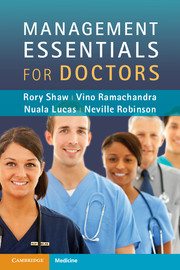Book contents
- Frontmatter
- Contents
- Contributors
- Foreword
- Preface
- Acknowledgements
- Section 1 Core knowledge
- Chapter 1 Audit
- Chapter 2 Care bundles
- Chapter 3 Checklists
- Chapter 4 Clinical dashboards
- Chapter 5 Complaints procedure
- Chapter 6 European Working Time Directive
- Chapter 7 Good medical practice
- Chapter 8 Guidelines
- Chapter 9 Preparation of a curriculum vitae
- Chapter 10 Medical interviews
- Chapter 11 Role of the consultant
- Section 2 Core skills
- Section 3 Important bodies
- Section 4 Information, evidence and research
- Section 5 Money
- Section 6 NHS structures
- Section 7 Operations
- Section 8 Safety and quality
- Section 9 Staff issues
- Index
Chapter 8 - Guidelines
Published online by Cambridge University Press: 05 March 2012
- Frontmatter
- Contents
- Contributors
- Foreword
- Preface
- Acknowledgements
- Section 1 Core knowledge
- Chapter 1 Audit
- Chapter 2 Care bundles
- Chapter 3 Checklists
- Chapter 4 Clinical dashboards
- Chapter 5 Complaints procedure
- Chapter 6 European Working Time Directive
- Chapter 7 Good medical practice
- Chapter 8 Guidelines
- Chapter 9 Preparation of a curriculum vitae
- Chapter 10 Medical interviews
- Chapter 11 Role of the consultant
- Section 2 Core skills
- Section 3 Important bodies
- Section 4 Information, evidence and research
- Section 5 Money
- Section 6 NHS structures
- Section 7 Operations
- Section 8 Safety and quality
- Section 9 Staff issues
- Index
Summary
A guideline is a set of recommendations, based on best available evidence, that are designed to improve the delivery of healthcare. They can relate to patient care on an individual basis or to populations of patients. Guidelines are intended to provide guidance to healthcare professionals but not to replace clinical judgement; they differ from protocols in that they do not suggest a mandatory pathway of care.
Potential benefits of guidelines
The potential benefits of guidelines include:
Promotion of interventions or treatments of proven benefits leading to reduced morbidity and mortality, and improved quality of life. At the same time clinicians are alerted to interventions/treatments not supported by good evidence
Greater consistency of care locally and nationally, benefiting patients. This is also associated with more efficient use of resources and optimization of value or money in delivery of healthcare
Improved communication between patient and healthcare professionals, e.g. it is increasingly common for guidelines to be accompanied by a lay version for patients and the public. These empower patients and help them to make informed decisions
Their usefulness in developing quality improvement activities and standards to assess the clinical practice of individual health professionals (acting as a reference point for audit of an individual's or hospital's practice)
Positive impact on the development of national health policy by drawing attention to a wide variety of neglected patient groups, health problems or clinical services
Supporting education of new staff and staff returning to practice
Strengthening the multidisciplinary team.
- Type
- Chapter
- Information
- Management Essentials for Doctors , pp. 19 - 21Publisher: Cambridge University PressPrint publication year: 2011



